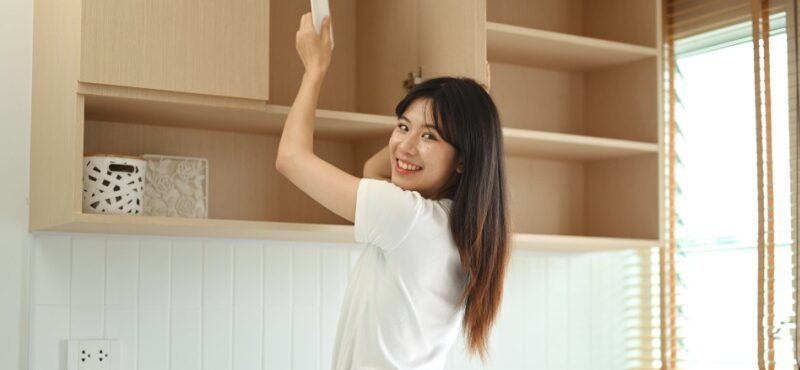When it comes to kitchen design, the choice between open shelving and closed cabinets is a divisive topic. Each option has its distinct advantages and disadvantages, making it a decision that depends on your personal style, functional needs, and the overall aesthetic of your kitchen. Today we’ll explore the pros and cons of both open shelving and closed cabinets to help you decide which is the best fit for your kitchen space. Whether you’re remodeling or building a new kitchen, understanding the differences between these two approaches will help you make an informed decision.
The Pros of Open Shelving
Accessibility and Convenience: One of the biggest advantages of open shelving is accessibility. With everything out in the open, it’s easy to grab items quickly without having to open and close cabinet doors. This is especially convenient for everyday items like dishes, glasses, and cookware. Open shelves also allow you to see everything at a glance, making it easier to locate what you need without rummaging through closed spaces.
Aesthetic Appeal: Open shelving can create a light, airy, and open feel in the kitchen, making it a popular choice for modern and minimalist designs. It allows homeowners to display attractive dishes, glassware, and even decorative items, turning functional storage into a design feature. The openness of the shelves can make a small kitchen appear larger, and the display of personal items can add a unique touch to the space.
Cost-Effective: Open shelving is generally more affordable than traditional closed cabinets. Without the cost of cabinet doors, hinges, and hardware, open shelves provide a budget-friendly storage solution. This makes open shelving a great option for homeowners looking to refresh their kitchen without a significant financial investment.
The Cons of Open Shelving
Maintenance and Dust: One of the biggest drawbacks of open shelving is the amount of maintenance required. Without doors to protect your items, open shelves are prone to dust and grease buildup, especially in kitchens where cooking often creates splatters. You’ll need to clean the shelves and the items on them regularly to keep them looking tidy and fresh.
Limited Storage Space: Open shelving often provides less storage space than closed cabinets. While it works well for displaying certain items, it’s not ideal for hiding clutter or storing less attractive kitchen essentials. If you have a lot of kitchen tools, food items, or miscellaneous gadgets, you may find that open shelving doesn’t offer the hidden storage you need.
Lack of Organization: While open shelves can look beautiful when neatly arranged, they can quickly become disorganized if not properly maintained. With everything visible, open shelving demands a high level of organization to avoid looking cluttered. This might not be ideal for households with busy lifestyles or those who prefer to keep their kitchen items out of sight.
The Pros of Closed Cabinets
Concealed Storage: Closed cabinets are perfect for those who prefer to keep their kitchen essentials hidden from view. With closed doors, you can store dishes, appliances, food items, and miscellaneous kitchen tools without worrying about how it looks. Closed cabinets allow for a cleaner, more streamlined appearance, making them an excellent choice for homeowners who want a minimalist or traditional look.
Protection from Dust and Grease: Unlike open shelving, closed cabinets protect your kitchen items from dust, grease, and other airborne particles. This means less cleaning and maintenance compared to open shelves, as your dishes and other stored items remain protected behind closed doors. This makes closed cabinets particularly ideal for busy kitchens where cooking is frequent.
Versatile Storage Options: Closed cabinets offer more storage flexibility than open shelving. With various cabinet sizes, depths, and configurations, you can customize your storage to suit your needs. Whether you need deep drawers for pots and pans or narrow cabinets for spices and small kitchen items, closed cabinets can be designed to accommodate a wide variety of storage needs.
The Cons of Closed Cabinets
Higher Cost: Closed cabinets are generally more expensive than open shelving due to the additional materials required for doors, hardware, and finishing. If you’re working with a tight budget, closed cabinets might take up a larger portion of your kitchen renovation costs. However, buying cabinets wholesale could alleviate some of these costs.
Visual Clutter: While closed cabinets keep your kitchen items hidden, they can also create visual clutter when there are too many cabinets lining the walls. In smaller kitchens, an abundance of closed cabinets can make the space feel more enclosed and heavy. Additionally, traditional cabinets can sometimes make a kitchen feel outdated compared to more open, modern designs.
Less Accessibility: With closed cabinets, you don’t have the instant accessibility that open shelving offers. Finding the items you need may require opening multiple doors and searching through drawers. This can be inconvenient for those who want quick and easy access to their kitchen essentials.
Finding the Right Balance
Both open shelving and closed cabinets have their advantages and disadvantages, and the best choice depends on your personal style, kitchen layout, and organizational needs. Open shelving is great for adding a modern, airy feel and showcasing attractive kitchen items, while closed cabinets provide hidden, protected storage for those who prefer a cleaner, more traditional look.
For many homeowners, the best approach is a mix of both. Incorporating open shelving in select areas—such as for displaying dishes or decorative items—while using closed cabinets for storing less visually appealing kitchen tools can create a balanced and functional design.
At Tops Kitchen Cabinet, we offer a wide range of wholesale cabinets to help you achieve the perfect balance between style and functionality in your kitchen. Visit our website to contact us and explore how we can help you design the kitchen of your dreams, whether you prefer open shelving, closed cabinets, or a combination of both.

